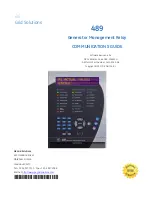
32
TB MRIK3 12.00 E
6.4.5
Checking the relay operating time
"For this test the AR function should be deactivated. The
number of automatic reclosing attempts "SHOT" should
be set to "EXIT".
To check the relay operating time, a timer must be con-
nected to the trip output relay contact. The timer should
be started simultaneously with the current injection in the
current input circuit and stopped by the trip relay con-
tact. Set the current to a value corresponding to twice
the operating value and inject the current instantane-
ously. The operating time measured by the timer should
have a deviation of less than 3% of the set value or
±
10
ms (DEFT). Accuracy for inverse time characteristics refer
to IEC 255-3.
Repeat the test on the other phases or with the inverse
time characteristics in the similar manner.
In case of inverse time characteristics the injected cur-
rent should be selected according to the characteristic
curve, e.g. two times I
S
. The tripping time may be red
from the characteristic curve diagram or calculated with
the equations given under "technical data".
Please observe that during the secondary injection test
the test current must be very stable, not deviating more
than 1%. Otherwise the test results may be wrong.
6.4.6
Checking the high set element
of the relay
Set a current above the set operating value of I>>. If
required an alarm relay can be tripped if in this moment
if it is assigned to this function. Check the tripping time
of the high set element according to chapter 6.4.5.
Check the accuracy of the operating current setting by
gradually increasing the injected current until the I>>
element picks up. Read the current value from the am-
meter and compare it with the desired setting.
Repeat the entire test on other phases and earth current
input circuits in the same manner.
Note !
Where test currents >4 x I
N
are used, the thermal with-
stand capability of the current paths has to be consid-
ered (see technical data, chapter 7.1).
6.4.7
Checking the auto reclosing function
The auto reclosing function can only be tested by means
of an auxiliary relay simulating the C.B. and a push but-
ton for manual start. In order to simplify testing, the sig-
nificant settings of the devices and the value of the test
current are provided as follows:
I>
= 0,8 x I
N
I> +CHAR
= DEFT
tI>
= 2 s
I>>
= 1,2 x I
N
tI>>
= 0,5 s
SHOT
= 1
tF
= 1,5
tD1
= 5 s
tD2
= 10 s
tCI
= 0,2 s
tR
= 10 s
tF + I>,I>>(IE>,IE>>)
= 1ST
CB (tCBFP)
= 2 s (EXIT)
f
N
= 50 Hz or 60 Hz
Relay assignment:
refer to default settings
AR-assignment:
I>
= YES
I>>
= YES
The test circuit must be set up in accordance with Figure
6.1. First the push button is pressed. The auxiliary relay
picks up and the LED CB lights up. With the settings of
the devices as shown above, a test current of 1.5 x I
N
should be injected on phase L1. When the pickup value
is exceeded, tripping takes place at once and the LEDs
I>> and L1 light up red.
The auxiliary relay releases again. The device changes
into the "Starting" status. This is signalled by the LED AR.
Now the dead time is running and the LED tD1 lights up
green. After expiration of the dead time the LED tCI
briefly lights up and the auxiliary relay trips again.
The display shows "CLOS".
The LED AR is alight furthermore, the O
→
I lights up
green and the LED tR lights up red. The LED tR signals
that the reclaim time is running. Once it has expired, all
LEDs extinguish except for the LED CB, and the display
shows "ISEG" again. This completes a successful AR
simulation.
Note:
After the relay has tripped, the test current should be
switched off as quickly as possible. Otherwise, there is
the danger that the switch failure protection device
CBFP picks up. If switching off quickly is impossible,
tCBFP must be set to "EXIT".















































